
Venus in Your Horoscope
The planet Venus is named after the Greek Goddess Aphrodite who represented everything that was beautiful. In Astrology and for horoscope purposes the influence of Venus is used to identify grace and creativity within a personality. It also highlights levels of a person's kindness, sensitivity and compassion. This planetary presence in a natal astrological reading additionally concerns and concentrates on the making of decisions. Venus cycles in orbit roughly once a year and so its influential power is widely spread between all twelve Western Astrology Sun signs. Its placement in your birth chart for horoscope analysis will indicate the strength of your emotional state and your decisiveness.
Venus is the second closest planet to the Sun and it is known as the Morning or Evening star as it is brightest at these times. It is a of similar size to Earth with a core, mantle and crust but its surface is covered with a layer of sulphuric acid clouds. The Venus atmosphere is made up of mainly carbon dioxide and it has a mysterious, dusty, desert type landscape. If someone has a strong presence of Venus in their astrological profile it usually indicates the likelihood of an attractive feature. Depending where and when Venus is displayed in a natal chart will determine which parts of the personality will be influenced.
There are only two or three well know myths that have a connection with the planet Venus. These tales are from the Romans, Mayans and Norse people who have passed them down though the centuries. The Roman's were responsible for renaming the Grecian deity Aphrodite to Venus and naming the planet in her image. The Mayan population believed that Venus was the planet of warfare and followed its path carefully. They designed their houses to be aligned in the best positions, especially windows and doors, for viewing it. In Norse mythology it is thought that one of the volcano's on Venus is named after the golden haired and very beautiful Norse Goddess Sif.
Most myths and legends about Venus though out history have signified this planet's association with beauty rather than war. The Mayan's were totally alone in their viewpoint of this planet's significance, most cultures regard it as the planet of love and maternal affection. It is significant for these reasons in terms of Astrology and towards horoscope interpretation. Wherever Venus is prevalent in someone's character reading will be enhanced with loveliness and a certain appeal. It will also emphasize their decisive or indecisive nature and sometimes the speed of their decisions or impulsiveness. This knowledge can be very revealing and provide clues to someone's way of thinking.
Peeking into and analyzing the positioning of Venus in a birth chart can reveal lots of little extras to a personality assessment. While it does not give general or specific revelations it is extremely useful in acquiring additional and relevant information. Looking at the location of Venus will be helpful in understanding it significancy in relation to all the other areas of a personality examination. Without studying this planet's occupancy in an individual's horoscope you can never gain a true reflection of how they relax. This is an important consideration and key to many parts of life including relationships. Knowing how you or another person like to indulge and what comforts you or them can be essential information.
The symbol for identifying Venus in Astrology charting consists of a simple circle and a cross. The circle of divine spirit sits on top of the cross of astral matter to form this basic icon. The shape of the Venus identifier is thought to represent the hand mirror of the Goddess Venus and symbolize beauty and charm. To remember the astrological symbol for Venus you should recall the image of a Goddess looking at her reflection. It should be easy to remember the relevance of Venus's presence and her introduction of refinement, gentleness and calm. It's influence is equally applicable to people as it is to situations and makes sense wherever it appears in a person's horoscope.
Venus is ruled by the two Western astrological Sun signs of Libra the Scales and Taurus the Bull. The section of the calculated birth reading that it is located in will be most affected by its beautification. Venus's influence does not always affect human appearance it is capable of influencing mannerisms, speech, charisma or a range of other personal and behavorial qualities. This part of a horoscope inspection can add a different perspective to some of the other discoveries uncovered by a mapping of a person's birth information. It can smooth negative traits and beautify unattractive ones by simply being present. An inspection of where Venus was in its yearly cycle when a person was born can make quite a difference to the gracefulness and appeal of their overall characteristics.
Venus Profile
Mass (kg) 4.87 x 1024
Diameter (km) 12104
Mean density (kg/m3) 5250
Escape velocity (m/s) 10400
Average distance from Sun 0.723 AU (108,208,930 km)
Rotation period (length of day in Earth days) 243.02 (retrograde)
Revolution period (length of year in Earth days) 224.7
Obliquity (tilt of axis degrees) 178
Orbit inclination (degrees) 3.39
Orbit eccentricity (deviation from circular) 0.007
Mean surface temperature (K) 726
Visual geometric albedo (reflectivity) 0.59
Highest point on surface Maxwell Montes
(17 km above mean planetary radius)
Atmospheric components
96% carbon dioxide, 3% nitrogen, 0.1% water vapor
Surface materials basaltic rock and altered materials
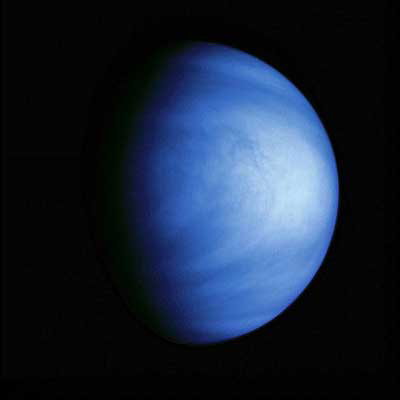
Venus in Color
The bluish hue of Venus is an effect of the colorization technique used to enhance subtle contrasts in cloud patterns and indicates that this image was taken through a violet filter. Features in the sulfuric acid clouds near the top of the planet's atmosphere are most prominent in violet and ultraviolet light. This image shows the east to west cloud banding and the brighter polar hoods . The features are embedded in winds that flow from east to west at about 370 kph (230 mph).
Twin Summit
Located in the Atla Regio region of Venus is Sapas Mons. The sides of the volcano are covered with numerous overlapping lava flows, many of which appear to have originated along the sides of the volcano rather than from its double summit. This type of eruption is common of large shield volcanoes on Earth, such as those found in Hawaii.
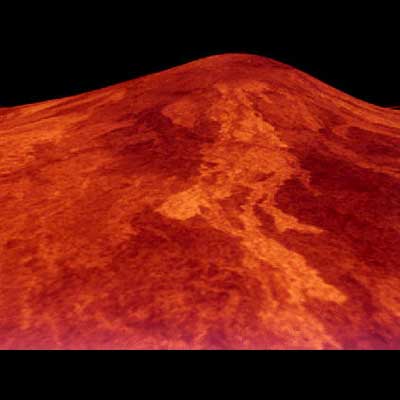
Recent Volcanism
This false-color view of the volcano Sif Mons was generated from Magellan SAR data and existing altimetry data. The image shows a region of the volcano just below the summit of the peak. A series of bright and dark lava flows is visible in the foreground. The brightest flows, which are relatively rough, are associated with the most recent volcanism in the region. The flows overlay older lava flows which are smoother and hence appear darker to the Magellan radar system. The volcano is 2 km (1.2 mi) high and 200 km (120 mi) in diameter. Vertical exaggeration in this image is about 20 times.
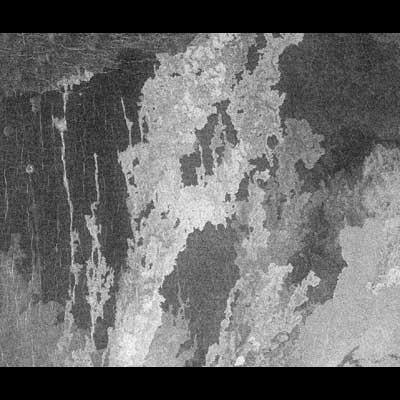
Sif Mons
Located on the slopes of Sif Mons, this area displays a simple sequence of events. The small shield volcanoes, features commonly found on Earth, are no more than 5 km (3 mi) in diameter. The dark background plains and the shield volcanoes both formed from the eruption of very fluid lava. Over time, several layers of lava flows covered each other, each one successively brighter, indicating that they became blockier in texture over time. The summits of the shield volcanoes protrude from the flows. Once the lava flows were in place, fractures formed as the new surface expanded.
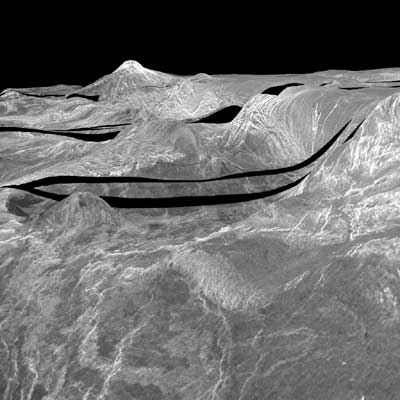
Lakshmi Planum
The southern scarp and basin province of western Ishtar Terra are portrayed in this vertically exaggerated 3-dimensional perspective view. Western Ishtar Terra is about the size of Australia and is a major focus of Magellan investigations. The highland terrain is centered on a 2.5 km to 4 km-high (1.5 mi to 2.5 mi-high) plateau, Lakshmi Planum, which can be seen in the distance at the right. Here, the surface of the plateau drops precipitously into the bounding lowlands. Vertical exaggeration in this image is about 20 times.
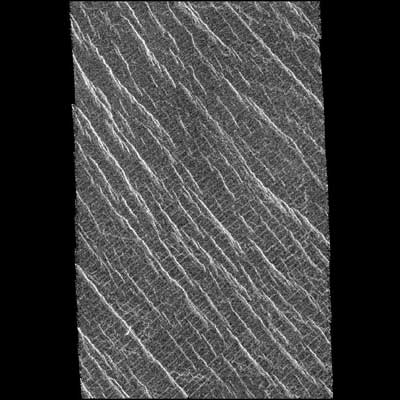
Parallel Lines
Two groups of parallel features that intersect almost at right angles are visible. The regularity of this terrain caused scientists to nickname it 'graph paper' terrain. The fainter lineations are spaced at intervals of about 1 km (.6 mi) and extend beyond the boundaries of the image. The brighter, more dominant lineations are less regular and often appear to begin and end where they intersect the fainter lineations. It is not yet clear whether the two sets of lineations represent faults or fractures, but in areas outside the image, the bright lineations are associated with pit craters and other volcanic features.
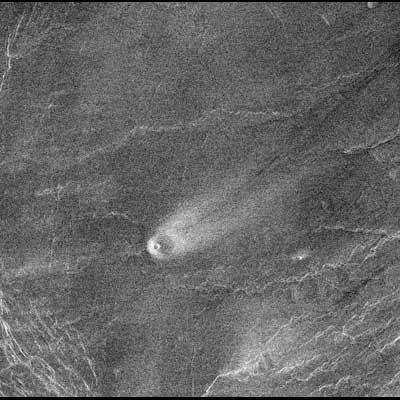
Crater with Streak
The comet-like tail lying northeast of this volcano is a relatively radar-bright deposit. The streak is 35 km (22 mi) long and 10 km (6 mi) wide. The volcano, whose diameter is 5 km (3 mi), blocks the wind so that particles in the atmosphere settle downwind from it.
Wind Streaks
Spectacular wind streaks were found NE of Crater Mead. The powerful impact that created Mead spread debris 500 km (310 mi) onto the surrounding plains. The radar-bright streaks most likely represent debris from the impact that have been modified by surface winds blowing from northwest to southeast. The radar-bright material is on top of an older, darker terrain.
Ash on Lava
In northern Navka, radar-dark wind streaks have been blown across radar-dark lava flows, indicating a SE-NW wind direction. The darkness of the streaks indicates they are composed of small, fine-grained material that is too smooth to return a strong radar signal. The radar-dark lava flows beneath the streaks are dark because they are smoother than the rougher, radar-bright lava flows to the left. Because the streaks are associated with lava flows, they may be composed of fine ash from the volcanic eruption that produced the flows.
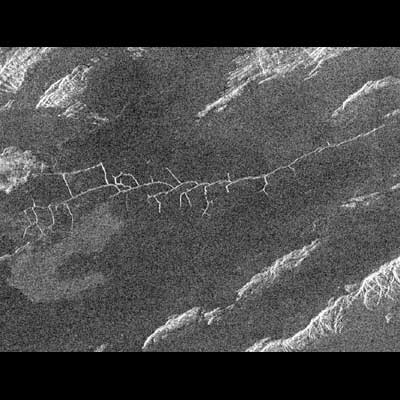
Tributary-Like Branches
In a region near Hestia Rupes on the NW corner of Aphrodite Terra lies a complex network of narrow (<1 km) bright channels. This network exhibits tributary-like branches similar to those observed in river systems on Earth. However, the angular intersections of these tributaries suggest control by faulting. The tributaries may be due to drainage of lava along preexisting fractures. The main tectonic fabric of this region can be observed in the NE-SW trending ridges.
Fault-Bounded Troughs
The large fault-bounded was nicknamed Gumby (after an animated cartoon figure) by Magellan scientists. Located in the Lavinia region at the intersection of two tectonic trends, Gumby measures 5 km (3 mi) wide and 100-200 m (.06 - .1 mi) deep. An example of one of the trends is the bright lines running E-W through Gumby's head. A second example is the bright lines running SW to NE through Gumby's legs and hips. The line of pits (by Gumby's elbow) suggests some igneous or volcanic activity may have accompanied the faulting.
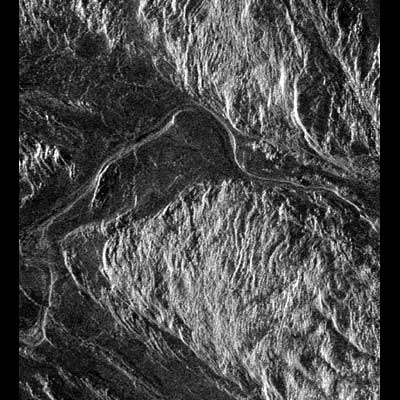
Long Channel
This long open channel in Vires-Akka Chasma ranges in width from under 1 km (3300 ft) to 4 km (2 mi). The portion of the channel visible here is over 120 km (72 mi) long. Scour lines are visible along the length of the channel, particularly where it makes abrupt turns. The channel may have been carved by very fluid lava that remained liquid as it flowed over great distances due to the extreme surface temperatures. Because the lava remained fluid it eroded preexisting terrain along its path.
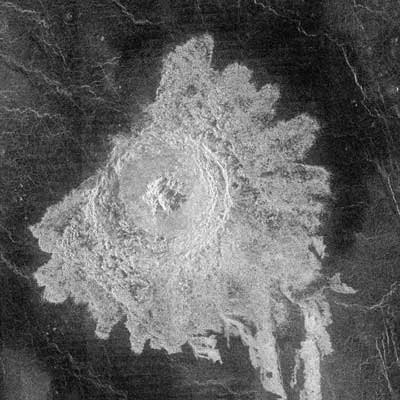
Large Impact Crater
A large impact crater about 30 km (19 mi) in diameter is surrounded by a fresh ejecta blanket. The extreme brightness of the blanket is due to its roughness and its ability to scatter the radar signals that are used to collect these images. Scientists believe that the missing section of the ejecta blanket is due to an atmospheric blast that followed the impactor as it crashed through the Venusian atmosphere.
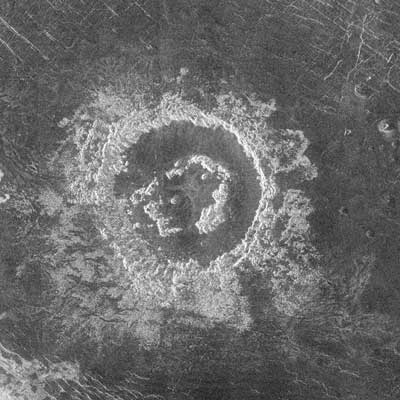
Peak-Ring Crater
This 54-km (32-mi) diameter crater is the size at which craters on Venus begin to possess peak-rings instead of a single central peak. The floor of Barton crater is flat and radar-dark, indicating possible infilling by lava flows sometime following the impact. Barton's central peak-ring is discontinuous and appears to have been disrupted or separated during or following the cratering process. The name Barton has been proposed by the Magellan Science Team, after Clara Barton, founder of the U. S. Red Cross; the name is tentative pending approval by the IAU.
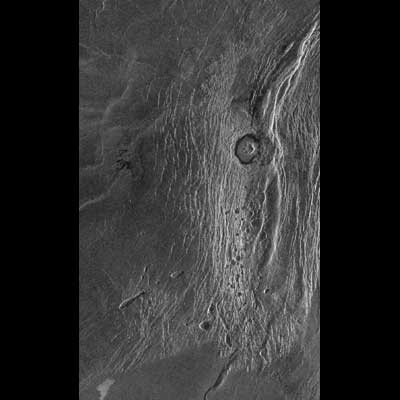
Akna Mountains
The Akna Mountains form the western edge of Lakshmi Planum. Wanda, the giant crater on the upper right, has a diameter of 18 km (11 mi). While Wanda doesn't appear to have been deformed by tectonics, material from the Akna Mountains appears to have collapsed into it. The area represented by this image is about 200 km (124 mi) long by 125 km (78 mi) wide.
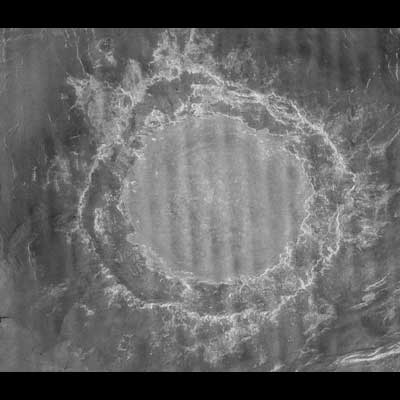
Largest Crater
Crater Mead is the largest known crater on Venus. Named after Margaret Mead, the American anthropologist, it measures 280 km (168 mi) in diameter and is located north of Aphrodite Terra and east of Eistla Regio. Classified as a multi-ring crater, Mead's innermost ring is thought to be the rim of the original crater cavity. The presence of irregular, radar-bright crater ejecta crossing the radar-dark floor terrace and adjacent outer radar-bright ring suggests that the terrace floor region is likely down-dropped and tilted outward, forming a concentric ring-fault.

Ticks
Scientists nicknamed this type of volcano a tick. About 66 km (41 mi) across at the base, this volcano has a flat, concave summit 35 km (22 mi) in diameter. The sides of the volcano are characterized by radiating ridges and valleys. To the west, the rim of the volcano appears to have been breached by dark lava flows that emanated from a shallow summit pit (5.4 km/3.3 mi in diameter) and traveled west along a channel. The black square represents missing data.
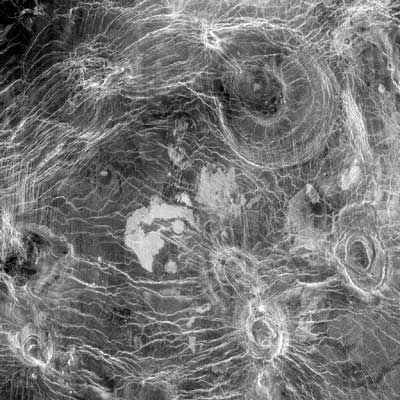
Arachnoids
Named by the Soviets for their spider and cobweb-like appearance, arachnoids are one of the more remarkable features found on Venus. They are 50 to 230 km (30 to 138 mi) diameter circular structures, with a central volcanic feature surrounded by a complex network of fractures. Arachnoids are similar in form but generally smaller than coronae. The radar- bright lines extending for many kilometers beyond the arachnoids may have been caused by an upwelling of magma from the interior of Venus, which pushed up the surface to form cracks.
In mythology :
Venus, the goddess of love and beauty, was the daughter of Jupiter and Dione. (In Homer's 'Iliad' Aphrodite is said to be the daughter of Zeus and Dione, a Titan goddess.) Others say that Venus sprang , full-grown, from the foam of the sea near the island Cythera. From there Zephyrus, the west wind, carried her gently on a shell to Cyprus, which was always regarded as her real home. There she was received and attired by the Seasons, and then led to the assembly of the gods.
All were charmed with her beauty, and each one demanded her for his wife. Jupiter gave her to Vulcan, the lame and ugly god of the forge, in gratitude for the service he had rendered in forging thunderbolts. So the most beautiful of the goddesses became the wife of the most ill-favoured of gods. This good-natured craftsman built her a splendid palace on Cyprus. Venus soon left him for Mars, the handsome god of war. One of their children was Cupid, the winged god of love.
Always eager to help lovers in distress, she was equally quick to punish those who resisted the call of love. Cupid shot golden arrows into the hearts of those his mother wanted to unite in marriage. Venus possessed an embroidered girdle called Cestus, which had the power of inspiring love and made its wearer irresistible, and she sometimes loaned it to others. Her favourite birds were swans and doves, and the plants sacred to her were the rose and the myrtle.
Aphrodite was worshiped chiefly as the goddess of human love. She was also widely venerated as a nature goddess. Because she came from the sea, sailors prayed to her to calm the wind and the waves. The poets of Greece and Rome never tired of singing the praises of the love goddess. Their sculptors carved countless figures of her. The most celebrated statue of Aphrodite in ancient times was that carved by Praxiteles at Cnidus, on the coast of Asia Minor. This has never been found by archaeologists. The most famous one that remains today is the beautiful 'Venus de Milo', now in the Louvre in Paris. In the 'Iliad' Aphrodite is called the Cyprian or Cytherea. She is also referred to as Dionaea, after her mother, or even Dione. Other names for her are Aphrogenia, Anadyomene, and Astarte. It is often written Ashtoreth, particularly in Bible references to Philistine idols. The name may have been derived from that of the Assyrian goddess Ishtar.
Comments: Venus Meaning, Sensual and Pleasure-loving